Dec 15, 2025
Dec 15, 2025
Plant Love and Symbolism - 1
Continued from Part LX
A significant contrast between the primary holy books of the major Abrahamic religions and the scriptures of Hinduism can be drawn from the fact that while the former, despite being professed as the ‘Word of God’, is believer and faithful centric with all other material creation in the world at their disposal for the use and consumption, the latter is not only concerned about the human beings (believers and non-believers included) but also with welfare, protection and preservation of all living beings including animals and plants, and even non-living things associated with the life. Therefore, every animal or plant which have been useful in some way for the continuation of life on the planet has been acknowledged with care and even deified many cases in the Hindu texts.
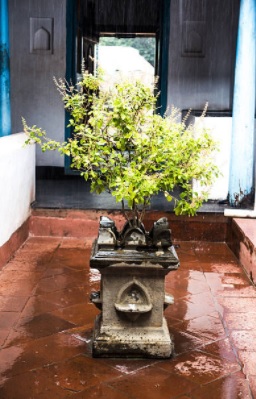 Even if we forget theology and spirituality for a while in favour of the science of evolution, ever since the man (Homo sapiens) evolved from his primitive primate ancestors, even during the pre-historic times when he started hunting of the wild animals for food, he was still heavily dependent on the plants and trees for the food, clothing and shelter. A large number of these plants and trees not only provided aforesaid basic needs for him but he also derived curative medicines and many other things of use from the very objects. Perhaps this is the reason why the enlightened and visionary rishis and scholars in the ancient time acknowledged the services rendered by the plants and, consequently, many mythical legends were evolved with the passage of time and people started recognizing them for the sacred ceremonies and as object of worship.
Even if we forget theology and spirituality for a while in favour of the science of evolution, ever since the man (Homo sapiens) evolved from his primitive primate ancestors, even during the pre-historic times when he started hunting of the wild animals for food, he was still heavily dependent on the plants and trees for the food, clothing and shelter. A large number of these plants and trees not only provided aforesaid basic needs for him but he also derived curative medicines and many other things of use from the very objects. Perhaps this is the reason why the enlightened and visionary rishis and scholars in the ancient time acknowledged the services rendered by the plants and, consequently, many mythical legends were evolved with the passage of time and people started recognizing them for the sacred ceremonies and as object of worship.
Significance of Plants & Plant Symbolism
Like animals, plants too are alive with all life activities sans the sensory ability and locomotion. They either do not have any sensory organs, or if at all they possess, it is very basic to meet minimum needs while animals have much more developed sensory organs and even a proper nervous system in more evolved species. While carrying out their life processes, plants generally remain rooted at a place but animals can move freely with the assistance of their locomotory organs. All other activities of the two are either complimentary to each other or carried out independently with a specific need or objective. For instance, Plants give off oxygen and intake carbon-dioxide while the animals do just the reverse of it. Similarly, plants have chlorophyll (green pigment) to prepare own food in the presence of sunlight with the water and carbon-dioxide while animals can’t prepare their food and fend for themselves to seek their food and sunlight.

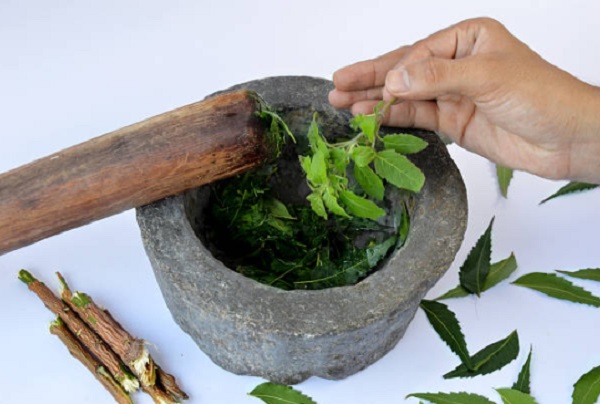
Right from the lowly evolved fungi varieties to highly evolved fruit bearing angiosperms, plant kingdom has millions of species of which the flowering plant species alone are nearly 3.69 lakh in number offering numerous uses and benefits to mankind. First and foremost, they are the main source of food particularly in countries like India where a large population still comprises of only the vegetarian people. In fact, nearly all parts of plants namely seed, fruit, flower, stem, root and leaves are selectively consumed by humans directly or through some allied process as staple diet for own nourishment as well as the domesticated animals. Besides, many plants particularly falling under the category of herbs and shrubs, and their products, are used as medicines as cure of several diseases. In addition, plants and trees are a source of wood for building and furniture, cotton for clothing, paper for writing and printing, fibre for bags/ropes, flowers and leaves for décor and perfumes, rubber for multiple uses, and so on, not to forget their valuable role and contribution in the environment protection and pollution control.
The Hindu scriptures teach the human beings to acknowledge and remember with gratitude the role and contribution of all living and non-living objects in this world, particularly things useful for their existence and life. In fact, there are many plants and trees without any substantive consummatory or commercial gain, yet some myth or religious belief has been attached with them. Usually in such cases, either due to some semblance with a deity or association with some sage or iconic personality in the ancient age, they are considered sacred and worshipped by the people. For instance, Tulasi (Ocimum sanctum) plant is linked with the god Vishnu; Gautam Buddha gained enlightenment under an Aswattha or peepal (Ficus religiosa) tree; Nyagrodha or Banyan (Ficus bengalensis) tree is linked with Vedic sage Kashyapa; similarly, many others such as Ashoka, Udumbara and Pundarika are associated with other ancient and conic personalities, hence treated sacred by Hindus and many Buddhists.

The aforesaid uses and symbolism of plants in Hinduism is deeply ingrained and well-marked in the ancient Indian historical texts like Puranas and Epics. It is also a paradox in the ancient Indian history that the traditional Indian sources have recorded the chronology of Hinduism from the Vedic age spanning over ten thousand years but the Western scholars and historians try to link it with only the Indus Valley civilization and thereby purportedly restricting Hindu civilization to less than four thousand years. While the former indeed has some missing links in the pre-Mahabharata era, the latter view appears altogether fallacious because it simply ignores many facts and events of the Indian subcontinental history. Nonetheless, even the Western scholars and historians agree that the identity of the plants with the deities was in vogue among Aryans of the Indus Valley civilization by linking the Soma plant with the moon. One such seal discovered at Mohenjo-Daro clearly depicted the Aswattha tree being worshipped by people.
The aforesaid one odd illustration of linking plants with deities only vindicates the age-old tradition of the Hinduism where a large number of plants have been symbolized with various deities. Some such associations include Tulasi (Ocimum sanctum) and Amalaka (Embelka myrobalam) with the sustenance god Vishnu; Bilva (Aegle marmelos) with the destroyer god Shiva; lotus (Nelumbo nucifera) with Vishnu’s consort goddess Lakshmi; and Kadam (Neolamarckia cadamba) with Shree Krishna. Actually, the importance of the trees in the life of human beings was recognized by the Vedic people and their benefits were narrated in many ancient texts. According to a legendary tale in the Matsya Purana, goddess Parvati had planted an Ashoka sapling. When the devas inquired from her about the merit of planting this sapling, she clarified them that the merit wise a Vapi was equal to ten wells, a pond to ten Vapis, a son to ten ponds and a tree was worth to ten sons. In essence, a fruit giving tree serves countless people in umpteen ways during its lifetime.
Apart from association with the gods and goddesses, some divine trees such as Akshayavat, Kalpavriksha, Parijaat and Kavu also exist with the legendary tales associated with them and people from various parts flocking around every year out of curiosity and reverence. A large number of other plants are also considered auspicious and their leaves, flowers and fruits are offered at the temples and cultural/religious ceremonies at homes. Similarly, dried wood and twigs of some plants like mango and sandal are used in sacrificial fire during Homa or Yajna in social and religious ceremonies. Although a wide range of flowers are used in such ceremonies, some common and popular flowers like Apacjit or butterfly pea (Clitoris ternate), Gudahul (Hibiscus rosa-sinensis), Aak (Calatropis gigantea), Datura (Datura fastuosa), Sehund (Euphorbia hguhria), etc., need a special mention.
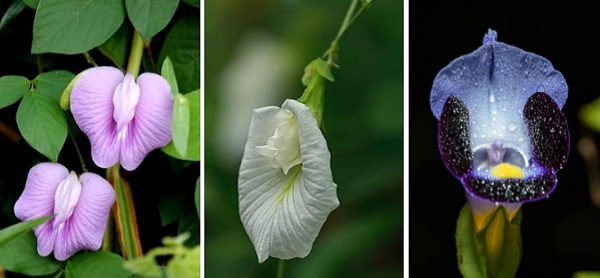
Apacjit is revered as a holy flower and is widely used in daily puja rituals. Its botanical name is derived from the human female genitals clitoris due to flower’s peculiar shape. Red Gudahal is said to be favourite of Goddess Kali (a fierce form of Shakti); Datura is favoured by Shiva; Sehund is linked to goddess Manasa (another form of Shakti); and Aak wood is used for Homa in sacrificial fire.
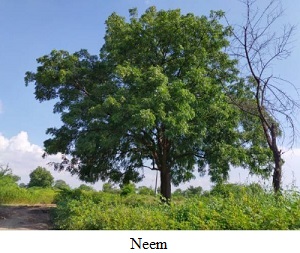 Many other plants and their products are used in socio-religious rituals and cure of many diseases. The commonly grown tree of Margossa (Azadirachta indica) aka Neem has many uses including medicinal value; traditionally, its leaves are chewed by people back from the death rites but certain tribes of Odisha also use it in the feast linked with the Lima rites following a death. Kusa grass (Eragrostis cynasuroides) is considered sacred by the Hindu priests who use it in nearly all religious ceremonies. Areca palm (Areca catechu) inflorescence use is considered auspicious by many families in marriage ceremonies in South India and Gujarat while it also has use in the treatment of the schizophrenia (a mental disorder) and glaucoma (eye disease). The odorous roots of Dhup (Dolomisea macroccphala) are widely used in the temples and Hindu households as incense and flowers offered to deities. The paste made from the Sandal (Santalum album) wood is applied to the forehead and extensively used in various religious ceremonies. These are only a few illustrations but, actually, the list of uses is rather too long.
Many other plants and their products are used in socio-religious rituals and cure of many diseases. The commonly grown tree of Margossa (Azadirachta indica) aka Neem has many uses including medicinal value; traditionally, its leaves are chewed by people back from the death rites but certain tribes of Odisha also use it in the feast linked with the Lima rites following a death. Kusa grass (Eragrostis cynasuroides) is considered sacred by the Hindu priests who use it in nearly all religious ceremonies. Areca palm (Areca catechu) inflorescence use is considered auspicious by many families in marriage ceremonies in South India and Gujarat while it also has use in the treatment of the schizophrenia (a mental disorder) and glaucoma (eye disease). The odorous roots of Dhup (Dolomisea macroccphala) are widely used in the temples and Hindu households as incense and flowers offered to deities. The paste made from the Sandal (Santalum album) wood is applied to the forehead and extensively used in various religious ceremonies. These are only a few illustrations but, actually, the list of uses is rather too long.
In Hinduism, the history of the tree worship is nearly as old as the civilization itself and the Puranas and Epics contain illustrations of trees as essential part of the mythology. This spirit is also commensurate with the general Hindu belief and intent to treat things with due regard and kind approach if it was useful to them in any way. Traditionally, India has remained a tropical rainy climate with persistent warm or high temperatures and a rather short winter season. In such a climate, the significance of plants and trees increases not only for the food and medicines but also for the greenery and shade to protect people from the scorching temperatures during the prolonged summer season. This was rightly learnt by the ancient sages and visionary ancestors who tried to make such a tradition as part of the religion in protecting and revering them for the overall welfare of the humanity and survival of the planet. Accordingly, the concept of Aranyani, goddess of the forest, also existed since the Vedic times.
Due to their overall significance and key role in human life since the Vedic age, the plants became the part of Hindu mythology too over a period of time. Accordingly, many plants are linked to various deities or even some plants themselves have been christened as a sacred deity receiving offerings from the followers. In ancient texts, including Rigveda, we often find mention of a venerated herb Soma, which was crushed and the juice was used in the rituals to invoke and propitiate Indra and possibly some other Vedic gods too. It is a common belief in Hinduism that many Devas were fond of or addicted to Soma juice in Vedic age. Similarly, in Atharvaveda and other texts, the darba grass and yava (barley) find a mention which are still part of Hindu socio-religious customs in many parts. Debates are still made if Soma was a healthy drink or an intoxicant but, as a matter of truth, another herb Bhang (Cannabis Indica) is still offered to Shiva in many temple rituals.
In many parts of the country, people follow the concept of Vana-devata (forest-god) and Vana-devi (forest-goddess), whereby cutting trees or destroying vegetation would tantamount to depriving the divine soul of its abode. Arguably, these deities are the synonymous aspects of the same Aranyani of the Vedic age, which is still in vogue in the rural parts of India. In some places, the same deity is also known as Van-chandi, and even some Muslims of the Sunderban delta are said to worship her as Bon-bibi. In classical Indian art, salabhanjika is depicted as a divine woman or Yakshi often holding a twig of Sal or Ashoka tree, thereby linking her with plants in various moods and interpretation. In Buddhism, she is depicted giving birth to Gautam Buddha while grasping the branch of Sal or Ashoka tree in hand; in Hindu traditions too, she is depicted with or without flowers or vine motifs in some South Indian temples.
Plants have been treated sacred and revered not only in Hinduism but other Indian religions such as Buddhism and Jainism too. For instance, the Peepal tree is linked with Buddha and Sal with Mahavira, who are believed to have received enlightenment under these trees. Many Hindu ascetics are still seen to prefer to sit and spend long time under the Banyan (or Vat) tree. According to a mythical tale in Hindu mythology, Vishnu took the form of a little baby floating on a banyan leaf during the great deluge (the waters of cosmic dissolution) while contemplating about the new creation. Child Shree Krishna is often shown with the Vat leaf sucking his own toe. One form of the goddess Durga is Shakambari as the mother of all vegetation and nine plants associated with the goddess during the Navaratri festival are banana, turmeric, pomegranate, bilva, rice, ashoka, jayanti, arum and taro. The worship of the most deities in Hinduism essentially involves coconut, betel leaves and areca nuts. In short, a great value has been attached to plants in Hinduism, and many of them are even worshipped and are part of the Hindu mythology.
The list of sacred plants and trees is too long and it would be difficult to do justice with even few such representative plants in a short writeup, hence the author proposes to deal with the subject in two parts. In this part, apart from the general aspects, a few legendary and mythical plants have been briefly illustrated while the second part would include the remaining sacred plants along with the uses and legends associated with them. Also, most such plants are remembered with different names in different parts; hence their scientific/botanical names have also been included with their common names for the ease of understanding.
Akshay Vat
Also known as Akshayavat (the indestructible banyan tree), it finds mention as a sacred fig tree in the Hindu mythology with many mythical tales associated with it. Akshay Vat finds a mention in the Ramayana as a tree located at Prayag where King Ram, wife Sita and younger brother Lakshaman had rested beneath it for some time during their exile of fourteen years. According to another account, Rishabha Dev, the first Tirthankar, of the Jain religion too had practiced tapa (penance) beneath the legendary tree at Prayag. The tree also finds a mention in the chronicles of some Western scholars like Edward Balfour and Alexander Cunningham of nineteenth century, and the travelogue of the Chinese Buddhist monk and traveller of seventh century.
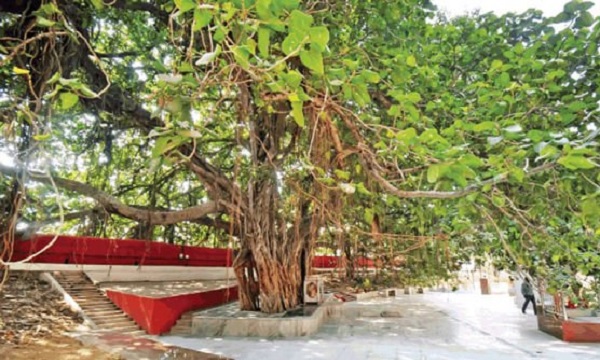
In the present age, a sacred fig tree is indeed located within the Patalpuri Temple at the Prayagraj (Prayag) Fort, which is worshipped as the Akshay Vat finding a place in the ancient Hindu texts. The aforesaid fort is a protected and classified military establishment and visitors need a simple permission from the local Commandant to visit the pilgrimage site. However, during the religious Kumbh Mela, the site is opened for all visitors for a limited span. According to another popular saying, the tree as visible at the aforesaid temple is not the original one, which is located at another underground temple inside the fort. Apparently, when the British took control of the Fort in 1765, they shifted the shrine to the present location at the fringes where the Patalpuri temple is located now to avoid access of the general public to the sensitive areas. This version is supported by the Welsh traveller Fanny Parkes, who is said to have visited both the tree sites in 1831; the 18th century map of the Fort from the British Library also vindicates this theory.
According to a legend from the Srimad Bhagavad Purana, sage Markandeya once requested god Narayana (Vishnu) to show the marvels of his divine power. Consequently, Narayana created an illusion of flooding the entire world for a moment, during which only the Akshay Vat could be seen above the water level with the God seen as a child floating on the fig leaf. The sage entered into His mouth to save himself from the inundating water. Inside the child’s body (stomach), Markandeya felt the entire world, all the seven continents and oceans, all the mountains, kingdoms, and everything including the living beings. Then he started praying to Vishnu with the request to withdraw his divine and magical spell. Vishnu now appeared before the sage in his original form and blessed him with his divine grace; thus inspired, the sage then composed the Bala Mukundashtakam. The sage Markandeya is said to have had a long life and the Markandeya Purana, that exists in his name, is one of the important texts of Shakti tradition.
According to Indian historian Jadunath Sarkar, the Moghul Emperor Jahangir tried to destroy Akshay Vat by cutting the tree to its root and hammering the remains of it with a red-hot cauldron but within a year, the tree grew again:
“The Emperor Jahangir cut the Akshay Bat tree of Allahabad down to its roots and hammered a red-hot iron cauldron in to it’s stump. He flattered himself that he had killed it. But lo! In a year the tree began to grow again.” (Shivaji – A Nation-Builder by JN Sarkar; page 443)
Kalpavriksha
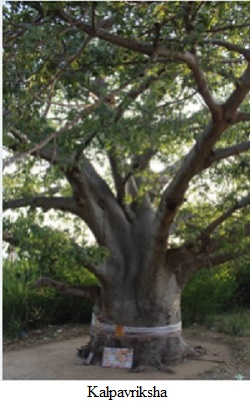 Kalpavriksha is also known as Kalpataru or Kalpadruma, which is a mythological plant associated with the fulfilment of wish in Hinduism and other Indian religions such as Buddhism and Jainism. According to an ancient mythical tale, Kalpavriksha had emerged from the primal waters during the Samudra Manthan i.e., the churning of the milky ocean, by the Devas and Asuras. This was retained by Indra, the king of Devas, who returned to his abode in Devaloka and planted it there for its quality of bestowing all needs to the retainer. According to yet another mythical legend, Kalpavriksha was actually located on earth but was taken away by Indra, when people started misusing it for the evil doings. The tree is often glorified in the Hindu iconography and literature too and, at times, different sacred trees such as Parijata, Banyan, Acacia, Mahua, etc., are linked with it in different parts of the country but, unlike the Akshay Vat, there is no uniformity about the exact place and type of the wish-granting tree.
Kalpavriksha is also known as Kalpataru or Kalpadruma, which is a mythological plant associated with the fulfilment of wish in Hinduism and other Indian religions such as Buddhism and Jainism. According to an ancient mythical tale, Kalpavriksha had emerged from the primal waters during the Samudra Manthan i.e., the churning of the milky ocean, by the Devas and Asuras. This was retained by Indra, the king of Devas, who returned to his abode in Devaloka and planted it there for its quality of bestowing all needs to the retainer. According to yet another mythical legend, Kalpavriksha was actually located on earth but was taken away by Indra, when people started misusing it for the evil doings. The tree is often glorified in the Hindu iconography and literature too and, at times, different sacred trees such as Parijata, Banyan, Acacia, Mahua, etc., are linked with it in different parts of the country but, unlike the Akshay Vat, there is no uniformity about the exact place and type of the wish-granting tree.
Another myth suggests that Indra had five such trees in the Devaloka, namely, Mandana, Parijata, Santana, Kalpavriksha and Harichandana, and all of these were capable of granting the desired wishes. The Kalpavriksha is said to have been planted at Mount Meru in the middle of five divine gardens in the Devaloka. On account of the wish-granting trees, the Devas were blessed with the divine flowers and fruits while the Asuras were deprived of these blessings. Thus, forced to live in penury, the Asuras used to constantly wage war against the Devas. According to another legendary tale in Padma Purana, the Kalpavriksha had granted a wish to the goddess Parvati and, consequently, her daughter Ashokasundari was born. According to a prophecy, goddess Ashokasundari was to marry Nahusha of the lunar dynasty. An Asura Hunda had a bad eye on the goddess and abducted her, which led to a fierce war between Nahusha and Hunda, who was killed by the former and the young goddess rescued. Eventually, King Nahusha and goddess Ashokasundari got married.
Basil – The Tulasi
 Basil or Tulasi is a cosmopolitan sacred plant under the category of herbs with many medicinal applications and mythical stories attached with it. The plant is erect, branched and two to three feet tall while its leaves are usually green or dark-green with toothed margins and dotted oil glands; and when crushed, the leaves give a strong fragrant scent. The flowers are small, usually purplish in slender spiked clusters, tiny fruits and yellow-red seeds. In Hinduism, apart from the religiosity, it also symbolizes purity and good health; hence many Hindu families raise at least one Basil plant in their households. Many Hindus also observe a ceremonial festival Tulsi Vivah any time between Prabodhini Ekadashi (the 11th lunar day of the bright fortnight) and Poornima (the full moon day) of the Kartik month of the Hindu calendar.
Basil or Tulasi is a cosmopolitan sacred plant under the category of herbs with many medicinal applications and mythical stories attached with it. The plant is erect, branched and two to three feet tall while its leaves are usually green or dark-green with toothed margins and dotted oil glands; and when crushed, the leaves give a strong fragrant scent. The flowers are small, usually purplish in slender spiked clusters, tiny fruits and yellow-red seeds. In Hinduism, apart from the religiosity, it also symbolizes purity and good health; hence many Hindu families raise at least one Basil plant in their households. Many Hindus also observe a ceremonial festival Tulsi Vivah any time between Prabodhini Ekadashi (the 11th lunar day of the bright fortnight) and Poornima (the full moon day) of the Kartik month of the Hindu calendar.
According to a popular ancient legend, Princess Vrunda, an ardent devotee of Vishnu, got married to a powerful Asura (Demon) King, Jalandhar and the two were leading a happy life. However, Jalandhar nurtured ambitions and waged a war against Devas who were defeated and lost their valued possessions to him. Now Devas jointly appealed Shiva, who learning that the demon king had a bad eye on his consort Parvati too, agreed to stop Jalandhar. When the war between the two remained undecided for a long period, the Devas learnt that the main cause for the demon king remaining undefeated was his faithful wife Vrunda, whose chastity and faith rendered even almighty Vishnu and Shiva ineffective against her husband. So, the Devas persuaded Vishnu to end her chastity for the greater cause of the protection and welfare of the universe. On his part, Jalandhar too was annoyed with Vrunda for her continued worship to Vishnu; when he could not dissuade her, he chopped her tongue, put her in a dungeon and, in penance, Vrunda blinded herself.
When the war broke between Jalandhar and Shiva, Vishnu released Vrunda from the dungeon in disguise of her demon husband, restored her eyesight and pretended to have changed with no malice towards Devas or any more war intention. While Vrunda and Vishnu disguised as Jalandhar was having nice time together, Shiva succeeded in killing Jalandhar in the battle field with the loss of her chastity. When the severed head of Jalandhar came in front of Vrunda, she found out the truth that her husband was killed and the one with her was actually Vishnu in disguise. She now decided to end her own life and cursed Vishnu to turn into a stone. God Vishnu, in deference, obliged and gave an edict that Vrunda will transform to the sacred Tulasi and henceforth he, as Shaligram, would be Tulasi’s eternal consort. Ever since, the Shaligram and Tulasi are worshipped together i.e., God Vishnu’s worship without sacred Tulsi leaves is considered incomplete.
Tulasi Vivah is an age-old tradition and is mentioned in the Padma Purana and some other ancient scriptures. Basil plant has a lot of medicinal uses. The juice of Tulasi eaves and seeds is considered effective in cough and colds as also in digestive problems. Then the plant is also an effective mosquito and fly repellent; the oil extracted from its leaves destroy harmful bacteria and keeps away many insects. The Tulasi leaves also have a unique property of curbing thirst and just chewing a few leaves is said to give an instant relief from thirst. Many Hindus remember the basil plant as the Little Shrub Goddess with the belief that its presence in the house is essential for the peace, happiness and prosperity. The basil is usually planted on a square pedestal in front of the house or even inside.
Kavu
The parts of Malabar Coast in Kerala are characterised with the sacred groves with Kavu as the traditional name given to such vegetation. Many terms like Sarpa Kavu and Iringole Kavu are also popular in the region. A Sarpa Kavu means the abode of snakes, which is earmarked as a sacred area near the traditional homes in Kerala, where offerings and rites are performed by people to please Naga Raja (king of snakes) and other snake deities. Similarly, the Iringole Kavu is a forest temple dedicated to Goddess Durga in Ernakulam district, which was consecrated by Parasuram, an avatar of Vishnu, according to local belief. The Kavus are also notable for Theyyam, a ritual dance worship in Kerala and some parts of Karnataka in India.
According to a legendary tale, Kerala was created from the Arabian sea by Parasuram and donated to the Brahmins (Namboothiris) as atonement for sins accrued due to continuous killings of the Kshatriya kings and warriors. As the area was full of forests and infested with poisonous snakes, the Brahmins were reluctant to settle there. So Parasuram requested Shiva for help, who told him to worship Anantha and Vasuki, the king of snakes. Parasuram complied with and, in turn, Anantha asked him to worship and earmark some parts of the forest specially for the snakes. Consequently, the idols of Anantha and Vasuki were installed, Sarpa Kayu were created and the Brahmins started worshipping the snake deities, who in turn allowed the area suitable for the human habitation.
Bodhi Tree
A Peepal tree (Ficus religiosa) located in the Bodh Gaya of the Gaya district in Bihar is known as Bodhi tree because Gautam Buddha is believed to have attained enlightenment under this tree.
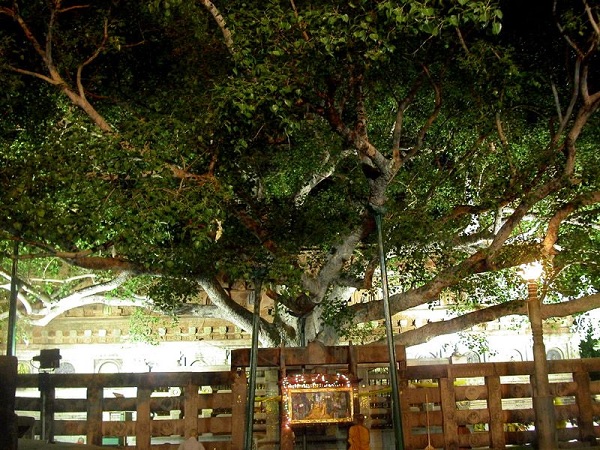
Buddha was born in Lumbini of the present-day Nepal in the royal family of Shakya dynasty of Hindu kings, who founded Buddhism after attaining enlightenment. Even before Buddha, the Peepal tree was treated sacred in Hinduism symbolizing the roots of the tree with the creator god Brahma, the leaves with the god Shiva associated with withdrawal and the trunk with the sustainer god Vishnu. In the Srimad Bhagavad Gita, Shree Krishna identifies Himself with the Peepal tree in the following verse that shall be considered as eternal glorification of the sacred tree establishing it as the most revered one in Hinduism.
Ashvatthah sarva-vrikshanam devarshinam cha naradah,
Gandharvanam chitrarathah siddhanam kapilo munih.
(Amongst trees I am the peepul tree, of the celestial sages I am Narad. Amongst the Gandharvas I am Chitrath, and amongst the siddhas I am the sage Kapil.) (BG: Chapter 10, Verse 26)
The Ashvattha (peepal tree) is usually a huge tree providing shade and soothing effect to the mind and body of people who choose to sit under it. The older tree expands by sending down several aerial roots, which support further horizontal and vertical growth providing shade and cooling effect to a large area particularly during the prolonged hot weather conditions. No wonder that Buddha chose Bodhi tree for his sustained meditation and attainment of wisdom.
Parijaat
The Parijaat tree is yet another legendary and sacred tree in Kintoor village of the district of Barabanki, India, which is perennially protected under the order of the district administration. In scientific jargon, it is called Adansonia digitata, and it is native in the Sub-sahara Africa where it is nicknamed baobab tree. Such trees are rare in Indian sub-continent with many legendary tales associated with it, including the one that this tree belongs to the Devaloka, which bore beautiful white flowers with orange trunk planted near the abode of the King Indra. Though the exact age of the tree has not been determined but it indeed appears to be of a very old vintage.
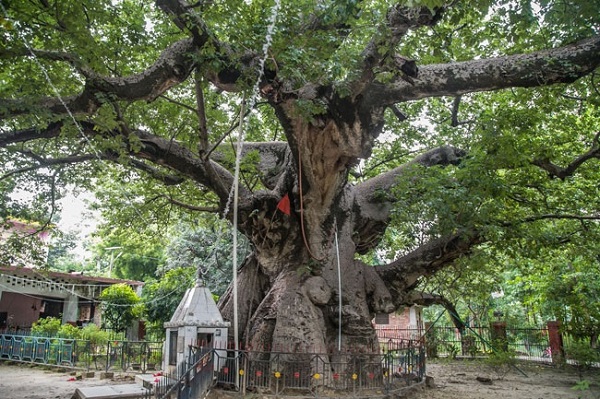
The place Kintoor is named after Kunti, who is a legendary character and mother of the Pandavas of the Mahabharata age. The place is characterized by the remains of a number of ancient temples and the tree is located near a temple, believed to be established by Kunti. According to a legend, the tree was brought by Prince Arjuna from the Devaloka, the abode of Indra, and was planted by Kunti at its present place. She was a devotee of Shiva and used to regularly offer and crown him with its flowers. Yet another mythical tale links it with Krishna and his two consorts Rukmini and Satyabhama. In Harivansh Purana, the Parijaat tree is mentioned as the Kalpavriksha, the wish bearing tree. The place is of tourist attraction, local people worship the tree and many newlyweds also visit it to seek blessings for a happy and prosperous life.
Images (c) istock.com
28-Feb-2021
More by : Dr. Jaipal Singh